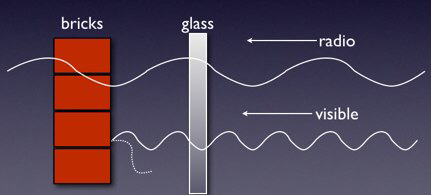Radio waves actually travel at the speed of light in vacuum, which is about 300,000,000 meters per second. It is fast enough for anyone on Earth to contact others on Earth in less a second. Radio waves are electromagnetic waves, so is light. The differences between light and radio waves are their frequencies and wavelengths.
Wavelengths with different sizes also have slightly different properties. For example, radio waves have a longer wavelength and lower frequencies, so they are less energetic than visible light and that is why radio waves have relatively no effects on human body.
It is also because of their differences in frequencies and wavelengths, radio waves can pass through certain materials that visible light can not. However, when light encounters a thick and opaque material, it is likely to be reflected or absorbed. That is why, people can use cellular services inside buildings but can not do so in elevators.





